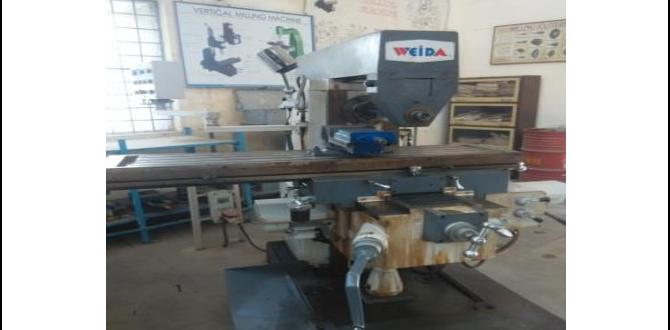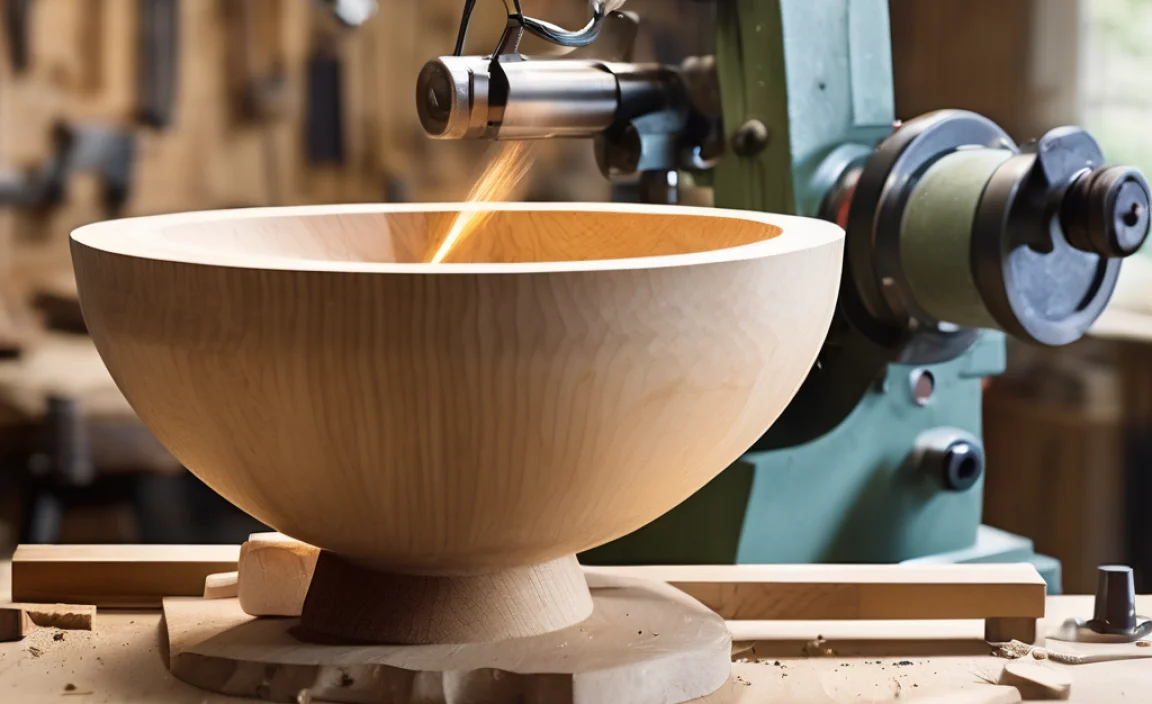A 1/8 inch carbide end mill is essential for precisely and efficiently machining carbon steel, offering superior hardness and heat resistance crucial for this tough material.
Working with carbon steel can feel a bit daunting, especially when you’re just starting out with your milling machine. You want to create clean cuts and intricate shapes, but sometimes the tools just don’t seem up to the task. It’s a common frustration to find your end mill chattering, breaking, or just not cutting cleanly. The good news is, the right tool can make all the difference. For those times when you need to tackle carbon steel, a 1/8 inch carbide end mill with the right specifications is your go-to solution. It’s designed to handle the toughness of steel, giving you reliable results. This guide will break down exactly why this small but mighty tool is so important and how to use it effectively.
Why a 1/8 Inch Carbide End Mill is Your Carbon Steel Best Friend
When you think about milling carbon steel, you might picture a tough, unforgiving material. And you’re right, it is! This is where tool selection becomes paramount. Not all end mills are created equal, and when it comes to carbon steel, you need something that can withstand high temperatures and resist wear. That’s where carbide shines.
The Magic of Carbide
Carbide, specifically tungsten carbide, is an extremely hard material. It’s significantly harder than high-speed steel (HSS), which is what many general-purpose end mills are made from. This hardness means carbide end mills can:
- Cut harder materials like carbon steel more easily.
- Maintain a sharp cutting edge for longer periods.
- Withstand higher cutting speeds and temperatures without deforming or losing their edge.
- Produce a finer surface finish on the workpiece.
For carbon steel, these properties are not just nice to have; they are essential for getting good results and prolonging the life of your tooling.
The 1/8 Inch Advantage
The 1/8 inch size of the end mill is also key for certain operations. Smaller end mills allow you to:
- Machine finer details and smaller features.
- Access tight corners and pockets that larger tools can’t reach.
- Perform intricate engraving or texturing.
- Reduce the amount of material removed per pass, leading to a smoother cut and less stress on the machine and the tool, especially when starting out.
When combined with the toughness of carbide, a 1/8 inch size becomes incredibly versatile for detailed work on carbon steel.
What About That “Reduced Neck” Feature?
You might see specifications like “1/8 inch carbide end mill 3/8 shank reduced neck.” This refers to the shank (the part that goes into your collet or tool holder) being larger than the cutting diameter (1/8 inch). A common shank size for a 1/8 inch cutter might be 1/4 inch or 3/8 inch. The “reduced neck” might refer to a slight taper just above the cutting flutes, which can help prevent the shank from colliding with the workpiece during deep slotting or pocketing operations. It’s a design feature that adds clearance, making the tool more functional in certain geometries.
Furthermore, the term “MQL friendly” indicates that the end mill is designed to work well with Minimum Quantity Lubrication systems. MQL is a technique where a very small amount of coolant and air is sprayed directly onto the cutting edge. This helps to cool the tool, evacuate chips, and lubricate the cut, all of which are beneficial when machining tough materials like carbon steel, and it’s a more environmentally friendly approach than flood coolant.
Key Specifications to Look For
When you’re out shopping for your 1/8 inch carbide end mill for carbon steel, keep these critical specifications in mind. They will help you choose the right tool for the job and ensure you get the best performance.
Material: Carbide is a Must
As we discussed, for carbon steel, 100% carbide is non-negotiable. Look for terms like “tungsten carbide,” “solid carbide,” or just “carbide.” Avoid tools labeled as “high-speed steel” (HSS) or “cobalt” if your primary target is carbon steel. While HSS can work in a pinch for very shallow cuts or softer steels, it will rapidly dull and can lead to frustrating results with carbon steel.
Number of Flutes
This is a crucial factor for milling steel. Flutes are the helical grooves that cut the material.
- 2 Flutes: Generally offer better chip clearance and are ideal for plunging (drilling into the material) and slotting. For aluminum and plastics, fewer flutes are often preferred. For steel, two flutes are a good starting point for many applications.
- 3 Flutes: Provide a good balance between chip clearance and surface finish. They can handle steel well and offer a smoother finish than 2-flute cutters.
- 4 Flutes: Offer the best surface finish and rigidity but have reduced chip clearance. They are excellent for finishing passes and general milling in steel, but can sometimes lead to chip packing in deep slots.
For working with carbon steel, especially with a 1/8 inch end mill where chip evacuation can be a challenge, a 2-flute or 3-flute carbide end mill is typically recommended.
Helix Angle
The helix angle is the angle of the flutes. Common angles are 30°, 45°, and 60°.
- High Helix (e.g., 45°-60°): These cutters provide shearing action, which leads to smoother cuts, better chip evacuation, and reduced cutting forces. They are often preferred for tougher materials like steel and stainless steel.
- Standard Helix (e.g., 30°): A good all-around choice that balances cutting performance and tool strength.
For carbon steel, a high helix angle (around 45°) end mill is generally a great choice.
Coating
Coatings add a layer to the carbide that further enhances its performance. For carbon steel, consider:
- TiN (Titanium Nitride): A general-purpose coating, good for wear resistance and reducing friction. It adds a golden color.
- TiAlN (Titanium Aluminum Nitride) or AlTiN (Aluminum Titanium Nitride): Excellent for high-temperature applications and machining harder metals like steel. They can withstand very high cutting temperatures and improve tool life significantly. These coatings are often dark purple or black.
- ZrN (Zirconium Nitride): Offers good lubricity and wear resistance.
For carbon steel, a tool with a TiAlN or AlTiN coating will provide the best durability and performance.
Shank Diameter
As mentioned, you’ll often see a larger shank diameter than the cutting diameter. For a 1/8 inch cutter, a 1/4 inch or 3/8 inch shank is common. This provides more rigidity and makes it easier to grip in standard collets or tool holders. A shank smaller than the cutting diameter would restrict movement and isn’t practical for this type of tool, unless it’s specifically designed for that purpose with great care.
Square End vs. Ball End
A “square end” mill has a flat cutting end, suitable for creating slots, pockets, and profiles. A “ball end” mill has a rounded cutting end, perfect for creating curved surfaces, contours, and fillets.
- Square End: Most common for general-purpose pocketing, profiling, and facing.
- Ball End: Essential for 3D contouring, creating rounded internal corners (fillets), and machining complex shapes.
For general milling operations on carbon steel, a square end 1/8 inch carbide end mill is usually the starting point. If you need to machine fillets, you’ll need a ball end mill.
Essential Tools and Setup for Using Your End Mill
Using a 1/8 inch carbide end mill on carbon steel requires more than just the end mill itself. Having the right supporting tools and setting up your machine correctly is vital for success and safety.
Your Milling Machine
Whether you have a small desktop CNC mill, a manual mill, or something larger, ensure it’s in good working order. For a 1/8 inch end mill, even a smaller, lighter milling machine (like a Sherline, Taig, or a small benchtop CNC like a Vevor or Genmitsu) can be capable, provided you:
- Use appropriate speeds and feeds (more on this later).
- Ensure the machine is rigid and free of excessive play in the axes.
- Keep it clean!]
For heavier-duty manual machines, you’ll have more power and rigidity to push the tool a bit harder, but precision is still key.
Collets and Tool Holders
You need a way to hold the end mill securely. This is usually done with a collet system or a chuck.
- Collets: These are precision sleeves that grip the shank of the end mill. Using the correct size collet for the shank diameter (e.g., a 1/4 inch collet for a 1/4 inch shank) is crucial for concentricity (ensuring the tool runs true) and preventing runout, which can cause vibration and tool breakage.
- Tool Holders/Chuck: The collet then fits into a tool holder or chuck that attaches to your machine’s spindle.
A quality collet set that covers your common shank sizes (like 1/8″, 3/16″, 1/4″, 3/8″) is a worthwhile investment.
Coolant/Lubrication (MQL)
While some carbide end mills can run dry, especially at lower depths of cut and feed rates, using a lubricant is highly recommended for carbon steel. It extends tool life, improves chip evacuation, and results in a better surface finish.
- Minimum Quantity Lubrication (MQL): As mentioned, this is ideal. A dedicated MQL system sprays a fine mist of cutting fluid directly at the cutting zone using a nozzle. This is efficient, uses minimal fluid, and keeps the cutting area clean. Many CNC machines can be retrofitted with MQL systems.
- Cutting Fluid/Paste: For manual machines or simpler setups, you can use a suitable cutting fluid or paste. Apply it regularly to the cutting area with a brush or applicator. Look for fluids specifically designed for machining steel.
For MQL friendly end mills, proper setup of an MQL system is key to unlocking their full potential.
Safety Gear!
This is non-negotiable. When machining, always wear:
- Safety Glasses: Protect your eyes from flying chips and debris. Wrap-around styles are best.
- Hearing Protection: Milling can be loud.
- Gloves (optional, and with caution): Wear snug-fitting gloves to protect your hands, but be extremely careful they don’t get caught in moving parts. Never wear loose-fitting gloves near rotating machinery.
- Appropriate Clothing: Avoid loose sleeves or clothing that could get caught. Tie back long hair.
Measuring Tools
You’ll need calipers and possibly a micrometer to accurately measure your workpiece and ensure your dimensions are correct. A dial indicator is useful for setting work offsets and checking runout.
Understanding Speeds and Feeds
This is perhaps the most critical aspect for beginners when milling carbon steel. Speeds and feeds determine how fast the tool rotates (spindle speed, RPM) and how fast it moves through the material (feed rate, inches per minute or mm per minute).
Spindle Speed (RPM)
This is the rotational speed of your machine’s spindle. For 1/8 inch carbide end mills in carbon steel, you’ll typically be in a moderate to lower RPM range.
- General Rule: Carbide tools can often run faster than HSS, but for tough materials like carbon steel and smaller diameter tools, it’s better to start conservatively.
- Calculation: A common starting point is to use a feed-per-tooth value and a surface speed value.
Surface Speed (SFM or m/min) is the speed of the cutting edge as it moves through the material.
RPM = (Surface Speed 3.82) / Tool Diameter (inches)
For 1/8″ carbide in steel, a surface speed might range from 150-300 SFM.
- Example: Let’s aim for 200 SFM with a 1/8″ (0.125″) end mill.
RPM = (200 3.82) / 0.125 = 6112 RPM.
However, consider your machine’s capabilities and the rigidity of your setup. Many smaller milling machines may not achieve high RPMs reliably, and sometimes lower RPMs work better with smaller tools in tough materials.
Feed Rate (IPM)
This is how fast the tool is pushed into or across the material. It’s often described in “feed per tooth” (FPT).
- Feed Per Tooth (FPT): This is the amount of material removed by each cutting edge (flute) in one revolution. For a 1/8 inch carbide end mill in carbon steel, FPT can range from 0.0005″ to 0.002″. A good starting point might be 0.001″ FPT.
- Calculation: Feed Rate (IPM) = RPM Number of Flutes FPT
- Example: Using our calculated 6112 RPM with a 2-flute end mill and 0.001″ FPT:
Feed Rate = 6112 2 0.001 = 12.22 IPM.
This number will often seem very slow to beginners, but it’s necessary for controlling the cut, prolonging tool life, and achieving good chip formation.
Chip Load Chart
The best way to get reliable speeds and feeds is to consult a chip load chart. Many tool manufacturers provide these. Always check the manufacturer’s recommendations for the specific end mill you are using. Here’s a simplified example:
| Material | Tool Diameter | Flutes | Surface Speed (SFM) | Feed Per Tooth (IPM) | Recommended RPM (for 2 flutes) | Approx. Feed Rate (IPM for 2 flutes) |
|---|---|---|---|---|---|---|
| Carbon Steel | 1/8″ (.125″) | 2 | 150 – 250 | 0.0008″ – 0.0015″ | 3820 – 6112 | 6 – 18 |
| Carbon Steel | 1/8″ (.125″) | 3 | 150 – 250 | 0.0005″ – 0.0010″ | 3820 – 6112 | 6 – 18 |
Important Considerations:
- Depth of Cut (DOC) and Width of Cut (WOC): The suggested speeds and feeds are usually for a standard depth and width of cut (e.g., DOC = 0.5 Tool Diameter, WOC = 0.5 Tool Diameter). For deeper cuts or full-width slots, you may need to reduce speeds and feeds.
- Machine Rigidity: A less rigid machine requires slower speeds and feeds.
- Tool Sharpness: As a tool wears, you may need to adjust.
- Lubrication: Effective MQL or coolant can allow for slightly more aggressive parameters.
Always err on the side of caution when starting. Listen to the machine and the cut. If you hear chattering or see excessive vibration, slow down your feed rate or reduce your RPM.
Step-by-Step Guide: Machining Carbon Steel with a 1/8″ Carbide End Mill
Let’s walk through a typical milling operation. We’ll assume you’re milling a simple pocket in a piece of carbon steel plate.
Step 1: Prepare Your Machine and Workpiece
- Clean Your Machine: Ensure your mill’s ways, lead screws, and tool holders are clean and lubricated.
- Secure the Workpiece: Clamp your carbon steel workpiece firmly to the milling table using a vise or clamps. Ensure the surface you’re machining is accessible and that your






